|
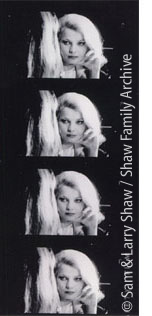 ....Faces
came out of one of the most troubled times in the filmmaker's life.
In the early 1960s, Cassavetes had a disastrous series of clashes with
a group of high-powered producers and executives on two studio films.
He was young, idealistic, and inexperienced, and could hardly believe
the way he was treated when he was fired from the second project. ....Faces
came out of one of the most troubled times in the filmmaker's life.
In the early 1960s, Cassavetes had a disastrous series of clashes with
a group of high-powered producers and executives on two studio films.
He was young, idealistic, and inexperienced, and could hardly believe
the way he was treated when he was fired from the second project.
But rather than forgetting
the whole thing, he decided to make a movie about the kind of people
who
had made him so miserable. He made Faces to try to figure out
what made these guys tick – how they could be so entertaining
and so much fun to be with in some ways, and so awful in others. He
wanted to understand
what they were like when they were home with their wives. He wanted to
understand what their sex lives were like.
He told me he was puzzled all
the way through: he wrote the script in confusion and uncertainty; he
rehearsed and shot scenes in dozens of different ways to try to understand
how these men would have acted in a particular situation; he played and
replayed the footage on a Movieola to try to figure out what it was like
to be them.
But Cassavetes also told me
that a strange thing happened as he went along. His bitterness and
rage
slowly dissipated, and to his own surprise he began to feel a deep compassion
for these men. He realized things about their lives that he hadn't
before.
He began to feel sorry for them. He saw how unhappy and emotionally needy
they were – how insecure and desperate for love and approval.
He saw how they tortured themselves even more than they tortured
others. In short,
he let his film teach him.
 That's
what it means not to tell a canned story in the Hollywood way, not
to use the shooting process
to make a set of points you've already decided on before you walk onto
the set, but to explore difficult emotional territory. That's what
it
means to humble yourself before your material, and allow yourself to
learn from it – to use art as a way of understanding the hardest
and most complex parts of life. That's
what it means not to tell a canned story in the Hollywood way, not
to use the shooting process
to make a set of points you've already decided on before you walk onto
the set, but to explore difficult emotional territory. That's what
it
means to humble yourself before your material, and allow yourself to
learn from it – to use art as a way of understanding the hardest
and most complex parts of life.
To do this is to grapple with
genuine mysteries of who and what we are – not to be confused
with the sort of thing that Hitchcock, DePalma, Lynch, or the Coens
specialize
in. There's lots of mystification in contemporary film – the deliberate
withholding of information to thrill or titillate – but no mystery.
The uncertainties in thrillers are always cleared up by the final scene,
which
is to say they aren't mysteries at all. Cassavetes asks questions that
he doesn't know the answers to. His mysteries have the depth of life....
* * *
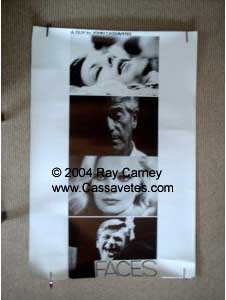 The
title of the shooting script of Faces was The Dinosaurs.
(An allusion is still present in the scene in which Billy Mae and Chettie
exchange "dinosaur" faces and growls.) The reference is not
only to the savagery of the men and the hardness of the women, but to
Cassavetes' belief that these characters were on the verge of extinction.
Faces was filmed between January and July of 1965, two years before
"The Sixties" were officially invented by the media, but the
artist doesn't wait to read about something in the newspapers. The dream
that the hippie migration to Haight-Ashbury was founded on, the idealism
that energized the protests against the Vietnam war – the vision
of a more sensitive and caring society, one that rejected the values of
late-twentieth-century capitalism – was Cassavetes' when he made
Faces. The
title of the shooting script of Faces was The Dinosaurs.
(An allusion is still present in the scene in which Billy Mae and Chettie
exchange "dinosaur" faces and growls.) The reference is not
only to the savagery of the men and the hardness of the women, but to
Cassavetes' belief that these characters were on the verge of extinction.
Faces was filmed between January and July of 1965, two years before
"The Sixties" were officially invented by the media, but the
artist doesn't wait to read about something in the newspapers. The dream
that the hippie migration to Haight-Ashbury was founded on, the idealism
that energized the protests against the Vietnam war – the vision
of a more sensitive and caring society, one that rejected the values of
late-twentieth-century capitalism – was Cassavetes' when he made
Faces.
Cassavetes' production methods,
here and in all of his work, were an implicit reply to capitalist forms
of organization. Rather than being organized like a hierarchical studio
bureaucracy, Cassavetes' cast and crew functioned like an extended family.
Amateurs and novices took turns doing jobs with professionals. No one
was confined to a single role. Crew members, like cameraman George Sims
or sound man Maurice McEndree performed other tasks like editing the film
or playing bit parts in it. Actors, like Seymour Cassel, ran wires, moved
lights, dressed the set, or painted walls.
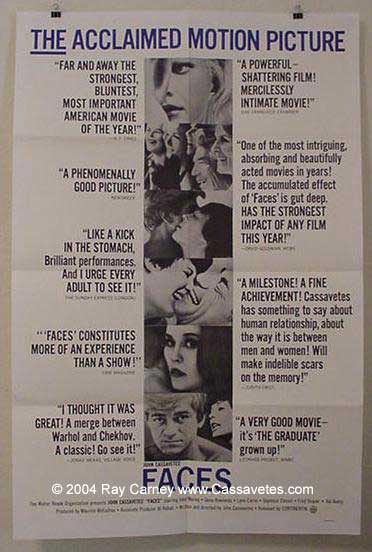 Since
most of the unpaid cast and crew had to hold other jobs during the day,
filming was limited to weekends and evenings, which is why most of Faces
takes place at night. The sets were Cassavetes' and Lady Rowlands'
own homes. (He shot five films in his home.) Cast and crew gathered in
Cassavetes' house in the evening, sometimes sharing a spaghetti supper
together, and shooting took place from 7 P.M. until midnight most nights. Since
most of the unpaid cast and crew had to hold other jobs during the day,
filming was limited to weekends and evenings, which is why most of Faces
takes place at night. The sets were Cassavetes' and Lady Rowlands'
own homes. (He shot five films in his home.) Cast and crew gathered in
Cassavetes' house in the evening, sometimes sharing a spaghetti supper
together, and shooting took place from 7 P.M. until midnight most nights.
This way of making a movie
represented a different conception of cinematic creation from the Hollywood
system from which Cassavetes had emerged. The family replaced the bureaucracy
as the fundamental model for interaction. Team-work replaced competitiveness.
Care about the project and responsiveness to one another's needs were
more important than individualism and star performances. The satisfaction
of working creatively was more important than financial rewards.
Jeannie and Chettie in particular
are Cassavetes' attempts to imagine a new masculine style of behavior
that breaks free from the competitiveness, toughness, and emotional guardedness
that Richard, Freddie, and McCarthy represent. If there were any doubt
about Cassavetes' feelings about Chettie, it should be resolved by the
film he made two years later. Minnie and Moskowitz uses the same
actor, playing an almost identical character (slightly updated from beach
boy to hippie), performing an almost identical narrative function to Chet's
in Faces. Like Chet here, Seymour Moskowitz is presented as an
explicit stylistic alternative to the dominant male culture (which in
Minnie and Moskowitz is embodied by Humphrey Bogart, Morgan Morgan,
Wallace Beery, Zelmo Swift, Jim, and Dick Henderson). In his press material
for Minnie and Moskowitz, Cassavetes called Seymour "a symbol
of hope."
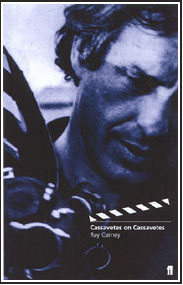 The
point is that even if he is the toughest and most unsentimental of artists,
all of Cassavetes' work is stunningly hopeful. It's not only that Chettie
and Jeannie represent ideals of male and female sensitivity and awareness
that are alternatives to the business values and competitiveness of the
other characters, but even Richard, McCarthy, Maria, Louise, and Florence
intermittently display the capacity to break their own patterns, to find
ways out of the emotional mazes they wander in. Cassavetes never gave
up on the possibility of possibility. He never abandoned the belief that
even the most trapped characters could come to see the error of their
ways and arrive at new understandings of themselves. He genuinely believed
one of the sayings his father used to repeat to him when he was a boy
(a line he later puts into Love Streams): "For every problem
there is a solution." The
point is that even if he is the toughest and most unsentimental of artists,
all of Cassavetes' work is stunningly hopeful. It's not only that Chettie
and Jeannie represent ideals of male and female sensitivity and awareness
that are alternatives to the business values and competitiveness of the
other characters, but even Richard, McCarthy, Maria, Louise, and Florence
intermittently display the capacity to break their own patterns, to find
ways out of the emotional mazes they wander in. Cassavetes never gave
up on the possibility of possibility. He never abandoned the belief that
even the most trapped characters could come to see the error of their
ways and arrive at new understandings of themselves. He genuinely believed
one of the sayings his father used to repeat to him when he was a boy
(a line he later puts into Love Streams): "For every problem
there is a solution."
Unfortunately, as the ending
of Faces tells us, and the 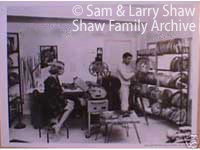 past
three decades of American culture prove, Chettie and Jeannie did not usher
in a new world. Cassavetes was mistaken. The dreams of the sixties did
not come to pass. The dinosaurs are not extinct; they are all around us.
America has yet to awake from the nightmare of Faces..... past
three decades of American culture prove, Chettie and Jeannie did not usher
in a new world. Cassavetes was mistaken. The dreams of the sixties did
not come to pass. The dinosaurs are not extinct; they are all around us.
America has yet to awake from the nightmare of Faces.....
Breaking
news! Ray Carney discovers a new print of Faces that contains
scenes deleted from the release print. Click
here to read about it.
This page only
contains excerpts and selected passages from Ray Carney's writing about
John Cassavetes. To obtain the complete text as well as the complete texts
of many pieces about Cassavetes that are not included on the web site,
click
here.
|









